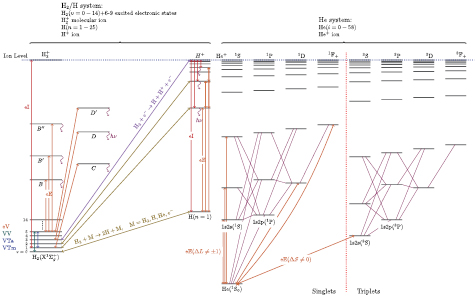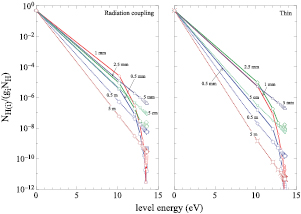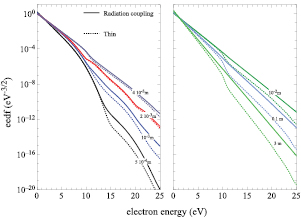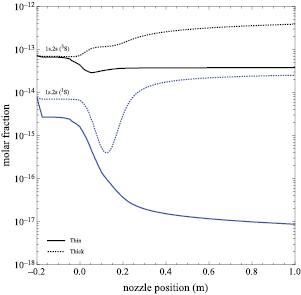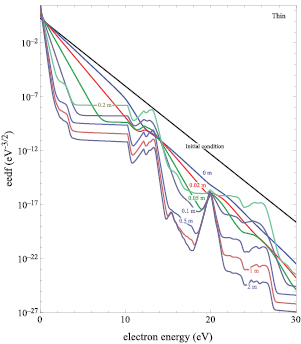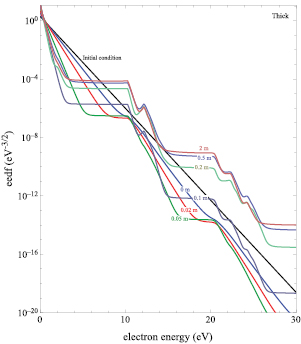Abstract
An advanced self-consistent plasma physics model including non-equilibrium vibrational kinetics, a collisional radiative model for atomic species, a Boltzmann solver for the electron energy distribution function, a radiation transport module coupled to a steady inviscid flow solver and, has been applied to study non-equilibrium in high enthalpy flows for Jupiter's atmosphere. Two systems have been considered, a hypersonic shock tube and nozzle expansion, emphasizing the role of radiation reabsorption on macroscopic and microscopic flow properties. Large differences are found between thin and thick plasma conditions not only for the distributions, but also for the macroscopic quantities. In particular, in the nozzle expansion case, the electron energy distribution functions are characterized by a rich structure induced by superelastic collisions between excited species and cold electrons.
Export citation and abstract BibTeX RIS
1. Introduction
Non-equilibrium plasma kinetics is a topic of large interest due to its wide use in different technological applications including negative ion sources for fusion [1, 2], microwave electrical discharges for diamond film formation [3, 4], parallel plates capacitive RF discharges for microelectronics [5–7], infrared [8] and excimer laser kinetics [9] and laser plasma interaction [10–12].
In the last 20 years there has been a growing interest in applying advanced plasma kinetics models to study the environment encountered by a vehicle during high-speed (re) entry in planetary atmospheres, including boundary layer flows [13–15], shock waves [16] and nozzle expansion flows [17, 18]. In these applications special attention is devoted to non-equilibrium vibrational kinetics and its coupling to electron energy distribution function (EEDF) [19–23] . Under many circumstances however the interaction vehicle-planetary atmosphere occurs at very large Mach numbers activating, in addition to the dissociation of molecules, the processes of ionization/recombination. This is for example the case of vehicles entering Jupiter atmosphere, mainly composed by H2 and He, at supersonic/hypersonic speed typically in the range 25–50 km s−1. Under these conditions, H2 molecules are almost completely dissociated and the formed atoms are also extensively ionized.
During atmospheric entry, the vehicle undergoes shock wave interaction at its front, while a plasma expansion region appears in the rear, where the radiative heating plays a relevant role [24, 25]. These two situations are very different from the point of view of plasma kinetics. During the shock wave formation there is an abrupt increase of translational temperature of heavy particles followed by an increase of both the electron temperature and concentration, a condition which can be described with good accuracy by a multi-temperature approach. The expansion regime, on the other hand, is characterized by a sudden decrease of the translational temperature of heavy particles and electrons, resulting in a recombining plasma. This condition can not be described by a multi-temperature model, since the latter completely disregards the possibility of forming non-equilibrium distributions of atomic/molecular excited states and free electrons as well, and a fully non-equilibrium state-to-state (STS) treatment of the plasma kinetics is mandatory to adequately describe the complex phenomenology. In particular the role of superelastic collisions involving electronically excited states and low energy electrons can play a major role in creating structures in the electron energy distribution function, which in turn affects the electron impact rate coefficients [11, 26]. The effectiveness of superelastic collisions is largely determined by the concentration of electronically excited states which in turn depends on the degree of reabsorption of photons emitted by atoms. The effect of reabsorption can be parametrically estimated reducing the Einstein coefficients for spontaneous emission between atomic levels i, j by the escape factor 0 ⩽ λij ⩽ 1 to account for reabsorption in radiative transitions. A fully consistent but costly approach requires an explicit modeling of radiation transfer in the gas and the self-consistent calculation of the rate coefficients of radiative processes.
Non-equilibrium effects on the EEDF are investigated solving a Boltzmann transport equation including second kind (superelastic) collisions as well as electron–electron Coulomb collisions, coupled to the kinetics described by a system of master equations for the distribution of atomic and molecular excited states. The radiation model plays a significant indirect control on the EEDF through its influence on the concentration of excited states, which in turns exchange energy with the free electrons through inelastic and superelastic collisions. Using the escape factor method, upper and lower limits to the influence of excited states on EEDF are obtained, corresponding to thin and thick plasma conditions.
In this work the interplay between radiation and EEDF is assessed using the Jupiter atmosphere kinetic model under shock wave and plasma expansion conditions. In order to obtain a reasonably complete description of the problem at hand, it is necessary to include (a) the vibrational kinetics of H2, (b) collisional radiative model (CRM) for both H and He atoms, (c) a plasma chemistry module for the dissociation and ionization processes and their reverse ones, (d) a radiative transfer module and (e) an Euler code to describe the fluid dynamics of shock wave and expansion regimes. This model is being developed in our laboratory and used in the present paper to emphasize the role of non-equilibrium plasma kinetics (in particular second kind collisions) in affecting shock waves and plasma expansion in the Jupiter atmosphere submitted to the interaction of a hypersonic vehicle entering in the planetary atmosphere. In particular we want to show the basic differences between the two cases (shock wave against plasma expansion) presenting dedicated numerical experiments. The paper is divided into four sections. After the introduction, section 2 presents a description of the numerical model, while sections 3.1 and 3.2 respectively report simulation results for the shock tube and nozzle expansion conditions in an H2/He plasma. Conclusions and perspectives are given in section 4.
2. Model description
The model used to obtain the numerical results presented in this paper is represented in figure 1. It comprises a collisional–radiative model for a plasma of H2(υ = 0 − 14),  (9 levels),
(9 levels),  , H(i = 1 − 25), H+, He(i = 0 − 58), He+ and e−, where H2(υ) is the hydrogen molecule in its ground electronic state
, H(i = 1 − 25), H+, He(i = 0 − 58), He+ and e−, where H2(υ) is the hydrogen molecule in its ground electronic state  ,
,  is an electronically excited state of the hydrogen molecule, H(i) is atomic hydrogen in an electronic state with principal quantum number i, and He(i) is atomic helium in an electronic state indexed by i. The energy level scheme of He is constructed by grouping closely spaced atomic levels of the real atom in different ways according to the principal quantum number n of the optical electron and total angular momentum quantum number L of the atomic term as follows [27] (i) for n ⩽ 4, each atomic term is a level in the atom, with energy calculated averaging over fine structure (ii) for n = 5 − 7 individual terms are retained for L < 3, while the remaining terms with L ⩾ 3 are grouped in a single level (iii) for n = 8 − 10 atomic levels within each n are grouped in a single level keeping singlet an triplet terms separate (iv) for 10 < n ⩽ 20 the model considers a level for each n with hydrogen-like energy and degeneracy. The resulting energy level scheme has 59 levels.
is an electronically excited state of the hydrogen molecule, H(i) is atomic hydrogen in an electronic state with principal quantum number i, and He(i) is atomic helium in an electronic state indexed by i. The energy level scheme of He is constructed by grouping closely spaced atomic levels of the real atom in different ways according to the principal quantum number n of the optical electron and total angular momentum quantum number L of the atomic term as follows [27] (i) for n ⩽ 4, each atomic term is a level in the atom, with energy calculated averaging over fine structure (ii) for n = 5 − 7 individual terms are retained for L < 3, while the remaining terms with L ⩾ 3 are grouped in a single level (iii) for n = 8 − 10 atomic levels within each n are grouped in a single level keeping singlet an triplet terms separate (iv) for 10 < n ⩽ 20 the model considers a level for each n with hydrogen-like energy and degeneracy. The resulting energy level scheme has 59 levels.
Figure 1. A schematic representation of the modules included in the numerical model.
Download figure:
Standard image High-resolution imageThe generalized CRM considered in this paper, represented in figure 2, takes into account a comprehensive kinetic scheme for the vibrational kinetics of  , including V–V mono-quantum transitions [28] (υ and ω are vibrational quantum numbers)
, including V–V mono-quantum transitions [28] (υ and ω are vibrational quantum numbers)

V–T energy transfer and dissociation


The rate coefficients for M = H, He have been calculated by Esposito et al in [29–32] using a quasi-classical trajectory method and the reader is referred to those papers and [33] for an in-depth discussion on their range of validity. Rate coefficients for the H2 + H2 V–T energy transfer have been estimated rescaling the vibrationally specific H2 + He rate coefficients by a temperature-dependent factor obtained comparing with the thermal rate coefficient of [34] due to the lack of level specific data at high temperature (5000–20 000 K) for the above process in literature.
Figure 2. A schematic representation of the H2/He collisional–radiative model used in this study.
Download figure:
Standard image High-resolution imageThe atom–atom excitation and ionization of A = H, He atoms


is very important under shock wave conditions and the relevant rate coefficients have been calculated using analytical expressions proposed by Drawin [35, 36].
Spontaneous radiative decay of electronically excited atoms

with A = H, He has been included using the Einstein coefficients for spontaneous emission of [37, 38] for H transitions and NIST's data [39] for He ones.
Electron impact processes include resonant vibrational excitation of  molecule and dissociative excitation through singlet and triplet molecular electronic states [40–43]
molecule and dissociative excitation through singlet and triplet molecular electronic states [40–43]



molecular ionization and electron-impact processes involving the molecular ion [44]





as well as electron impact excitation, ionization of atoms and radiative recombination of atomic ions [45–48]



with A = H, He.
The electron impact rate coefficients needed in the CRM are calculated from the EEDF as

and the EEDF is obtained solving the electron Boltzmann equation in compact form

where n(ε, t)dε is the number of electrons in the energy range (ε, ε + dε) at time t,  is the flux of electrons due to an the electric field,
is the flux of electrons due to an the electric field,  is flux of electrons due to elastic collisions with heavy particles,
is flux of electrons due to elastic collisions with heavy particles,  is the flux of electrons due to e–e collisions and Sin, Ssup are inelastic/superelastic collisions source terms. The Boltzmann equation is numerically solved using the formulation proposed by Rockwood [49] and the reader is referred to our previous works [17, 50, 51] for the full implementation details.
is the flux of electrons due to e–e collisions and Sin, Ssup are inelastic/superelastic collisions source terms. The Boltzmann equation is numerically solved using the formulation proposed by Rockwood [49] and the reader is referred to our previous works [17, 50, 51] for the full implementation details.
The complete STS kinetics and the Boltzmann equation are coupled to a quasi 1D steady state code [52] for solving the mass, momentum and energy conservation equations along the nozzle or shock tube (constant section) coordinate

where ρ, u and h are the mass density, velocity and enthalpy per unit mass, p is the total pressure, A is the nozzle section and ΔQrad accounts for radiative energy transfer or other external energy sources such as Joule heating. The shock tube and nozzle geometries considered in the present paper are represented in figure 3. Unsubscripted quantities in equation (20) refer to position x along the shock tube or nozzle axis, while subscripted quantities refer to the initial condition in the free stream (shock tube) or reservoir (nozzle) respectively. The gas pressure is determined using the ideal gas equation of state

where R is the ideal gas constant,  is the average molar weight of the mixture and T the gas temperature. The enthalpy per unit mass is composed by a translational contribution which also includes the heat capacity of degrees of freedom in equilibrium with translation and an internal contribution resulting from the degrees of freedom that are not assumed in thermal equilibrium
is the average molar weight of the mixture and T the gas temperature. The enthalpy per unit mass is composed by a translational contribution which also includes the heat capacity of degrees of freedom in equilibrium with translation and an internal contribution resulting from the degrees of freedom that are not assumed in thermal equilibrium



where xs is the molar fraction of the s-th species, hf, s the formation energy per particle of species s, εs, i the energy of the i-th energetic level of species s referred to its ground state and fsi the faction of s-particles in their i-th energy level. The quantity α is given by

where  for monoatomic species and the electron and
for monoatomic species and the electron and  for diatomic species.
for diatomic species.
Figure 3. Schemes of the two space geometries considered in this paper (a) the shock tube and (b) the F4 nozzle flow.
Download figure:
Standard image High-resolution imageTransport of radiation is described using the 1D radiative transfer equation (RTE) in slab geometry [53]

where Iν(x, μ) is the radiation intensity propagating along a ray with director cosine μ with respect to the x-axis. The term  is the spectral emissivity, κν(x) is the absorption coefficient corrected for stimulated emission. These spectral coefficients are calculated taking into account the bound–bound and bound-free radiative processes of atomic species as well as the free–free e-H+ radiation, neglecting the contribution of He+ having a very low concentration. The coupling between the RTE and chemical kinetics is due to the possibility of radiation reabsorption in atomic transitions, so that the net rate of a radiative transition between atomic levels i and j is given by
is the spectral emissivity, κν(x) is the absorption coefficient corrected for stimulated emission. These spectral coefficients are calculated taking into account the bound–bound and bound-free radiative processes of atomic species as well as the free–free e-H+ radiation, neglecting the contribution of He+ having a very low concentration. The coupling between the RTE and chemical kinetics is due to the possibility of radiation reabsorption in atomic transitions, so that the net rate of a radiative transition between atomic levels i and j is given by

where Aji, Bji and Bij are respectively the spontaneous emission, stimulated emission and absorption Einstein coefficients associated to the i ↔ j transition and

where ϕij is the normalized line shape of the i ↔ j transition, which has been modeled using an approximate Voigt function [54], taking into account the main line broadening mechanisms such as Doppler broadening, characterized by a Gaussian profile, as well as different kinds of pressure broadening [38] approximated by a Lorentzian profile. The average spectral intensity Jν(x) needed in equation (28) is directly calculated from the solution of the RTE, equation (26), as follows [53]

It should be remarked that radiation transport significantly adds to the computational time, due to the need of iterating to self-consistency the system of kinetic master equations for the level populations depending the rates in equation (27) and the spectral intensity obtained solving equation (26), which depends non-linearly on the level populations through the emissivity  and absorption coefficient κν. For the shock wave results reported in the following section, the calculation time for a serial run on an Intel 3.2 GHs i3 processor is about three days, to be compared with about 20 min required by a run neglecting radiation transport.
and absorption coefficient κν. For the shock wave results reported in the following section, the calculation time for a serial run on an Intel 3.2 GHs i3 processor is about three days, to be compared with about 20 min required by a run neglecting radiation transport.
3. Results and discussion
3.1. Shock wave
In this section we apply the model described in section 2 to investigate the non-equilibrium region behind a strong shock, under typical entry conditions in Jupiter's atmosphere. The geometry investigated in this section, corresponding to an 1D shock tube experiment, is represented in figure 3(a). In the free stream, the initial temperature and pressure are p0 = 700 Pa, T0 = 160 K and a free stream gas speed u0 = 28 441.85 m s−1, corresponding to a mach number M0 = u0/c ≈ 31. The cold gas is an H2/He mixture in molar ratio 89 : 11. The initial conditions have been chosen to reproduce the trajectory point at about 100 km of altitude from the planetary surface reported in the numerical rebuilding of Galileo's probe entry in Jupiter atmosphere of [55]. The shock wave problem is characterized by a sudden rise of temperature (T1 ≈ 31 000 K) and pressure (p1 ≈ 7.7 atm) while the gas speed becomes subsonic (u1 ≈ 4950 m s−1) just behind the shock wave.
The increase of translational temperature triggers the heavy particle impact processes (1)–(5). Due to the high impact speed, the gas is extensively ionized, with first electron generated by the atom–atom processes (5) and (12). When a sufficient electron number density is reached, the electron impact processes (7)–(17) are also activated and start to dominate the chemical kinetics behind the shock. Radiation is mostly generated by radiative decay of electronically excited atomic states, see equation (6) and provides a further energy transfer mechanism that is accounted for solving equation (26) through the plasma slab. In presenting the following results, we consider both the case when radiation transfer is fully coupled to the kinetics of excited electronic states of atoms through the self-consistent radiative rate coefficients given in equation (27) and the optically thin model which is obtained neglecting terms proportional to Jij in the same equation. The thick plasma case, obtained assuming that the radiative rates given by equation (27) are null, gives results which are very close to the those obtained in the self-consistent model under the present free stream conditions.
Figure 4 reports the composition profiles in the post-shock region as a function of the distance from the shock. The high heavy particles translational temperature just behind the shock front promotes H2 dissociation and ionization of the formed H atoms. Heavy particle impact processes, see equations (1)–(3) populate the excited vibrational levels of H2, which are successively dissociated, building up a large concentration of H atoms at about 0.1 mm from the shock front. H atom ionization starts at about 0.3–0.4 mm from the shock and is initially due to the atom–atom process (5) only, until a sufficient electron number density builds up, that increases the rates of electron impact ionization processes (16). Figure 4 shows that the optically thin composition is almost identical to the one obtained using the full model, except that for distances larger than 3 mm the concentration of charged species, mostly e− and H+ ions, is 2–3 times smaller of the corresponding one in the radiation coupled case. In this case the radiative losses are very efficient in cooling the H atom level distribution, providing an indirect mechanism of dissipation of the free electron translational energy. As a result, both the electron concentration and temperature are lower in an optically thin plasma compared to the radiation coupled model.
Figure 4. Post-shock molar fraction and profiles as a function of the distance from the shock front, calculated at the free stream conditions of section 3.1, using the radiation coupled model (solid lines) and in an optically thin plasma (dotted lines).
Download figure:
Standard image High-resolution imageFigure 5 shows the evolution of the translational gas temperature, together with the internal temperatures of both H and He atoms, comparing the radiation coupled model with both the plasma thin and plasma tick approximations. The internal temperatures of atomic species are calculated as the temperature of a Boltzmann distribution interpolating the population of the ground and first electronically excited state of the relevant atom. At shock distances x > 6·10−4 m the optically thick plasma approximation closely reproduces the results of the radiation coupled calculations, while at lower distances radiation reabsorption increases the population of electronically excited states in the full model. The optically thin approximation, on the other hand, overestimates radiation losses effects resulting in lower excited states populations.
Figure 5. Translational and internal atom temperature profiles calculated at the free stream conditions of section 3.1, using the radiation coupled model (solid lines) or under plasma thin (dotted lines) and plasma thick conditions (dashed lines).
Download figure:
Standard image High-resolution imageFigure 6 reports the normalized internal state distribution (ISD) of H atom, obtained dividing the molar fraction NH(i)/NH(NH is the total number density of H atoms) of the i-th atomic state H(i) by its statistical weight gi, at increasing distances from the shock front. At distances larger than about 5 mm the distributions are equilibrium. At smaller distances the distributions are characterized by underpopulated excited states due to the ionization process and a substantially larger population of the H(n = 2) and H(n = 3) excited states in the radiation coupled model compared to the plasma thin case.
Figure 6. Internal distribution of H atoms at different distances from the shock front, calculated at the free stream conditions of section 3.1, using the radiation coupled model (left) and in an optically thin plasma (right).
Download figure:
Standard image High-resolution imageFigure 7 compares the EEDF calculated by the radiation coupled model and the optically thin approximation. For distances lower than about 1 mm the optically thin distributions are underpopulated compared to the radiation coupled ones at electron energy values larger than about 10 eV due to a lesser effect of superelastic collisions involving the H(n = 1) resulting from the lower concentration of excited states in the thin case. On the other hand, for distances larger than about 1 cm, the radiation coupled distributions are essentially Maxwellian at the gas temperature, while in the optically thin case the decrease in the electron density concentration is such to avoid the thermalization of the EEDF by electron–electron collisions, while the concentration of excited states is not large enough to create significant superelastic structures on the EEDF induced by superelastic collisions. It is worth noting that in the present implementation, the coupling between radiation and the EEDF is indirect, through the inelastic and superelastic terms in equation (19). In particular, Ssup is affected by the concentration of excited states which is in turn strongly dependent on the assumed radiation model.
Figure 7. The EEDF at different distances from the shock front, calculated at the free stream conditions of section 3.1, using the radiation coupled model (solid lines) and in an optically thin plasma (dotted lines).
Download figure:
Standard image High-resolution imageFigure 8 reports the concentration profiles of the H(n = 2) and H(n = 3) excited states and the evolution of the average electron energy computed from the non-equilibrium EEDF. Reabsorption effects in the radiation coupled model tend to increase the concentration of atomic excited states at distances lower than about 6 · 10−4 m compared to both the plasma thin and thick assumption, while the average electron energy is independent on the optical model due to the low excited state and electron concentrations, which makes inelastic and superelastic collision processes negligible. This situation lasts up to about 3 · 10−3 m, where superelastic collisions between electrons and atomic excited states start to be effective, resulting in a larger average electron energy in the radiation coupled and plasma thick cases compared to the thin one, as a consequence of the larger excited state concentration in the first two cases.
Figure 8. Molar fraction profiles of the H(n = 2) and H(n = 3) and average electron energy 〈Ee〉 as a function of the distance from the shock front, calculated at the free stream conditions of section 3.1, using the radiation coupled model (solid lines) or under plasma thin (dotted lines) and plasma thick conditions (dashed lines).
Download figure:
Standard image High-resolution imageThe larger concentration of electronically excited states in the radiation coupled and plasma thick cases, coupled to the larger concentration of high energy electrons, see figure 7, results in a much larger ionization degree in the first two cases, with a peak electron concentration which is about 50% higher compared to the plasma thin assumption as shown in figure 9.
Figure 9. Electron number density profiles as a function of the distance from the shock front, calculated at the free stream conditions of section 3.1, using the radiation coupled model (solid lines) or under plasma thin (dotted lines) and plasma thick conditions (dashed lines).
Download figure:
Standard image High-resolution image3.2. Nozzle expansion
Let us now examine the behavior of the EEDF in the nozzle case for both thin and thick plasma situations. The nozzle geometry has been described in a previous work [56] and is schematically reproduced in figure 3(b). The initial temperature and pressure at the reservoir are T0 = 8000 K and p0 = 1 atm respectively, the chemical composition is obtained running the CRM to steady state while neglecting radiative processes. Moreover, the initial EEDF and distributions of excited H, He and H2 species are respectively Maxwell and Boltzmann at T0 = 8000 K.
Figure 10 reports the evolution of different translational (T and Te) and internal  , TH and THe) temperatures on the nozzle axis. In both the plasma thin and thick conditions, a strong decrease of T and Te along the nozzle axis is observed, caused by the supersonic expansion of the gas through the throat. The electron temperature in the thin plasma reaches a final value of about 800 K at a distance of 0.4 m from the nozzle throat, to be compared with a final value of about 2300 K in the thick case. The low values of Te in the thin case, associated to an appreciable density of electronically excited atomic states represent an ideal situation for enhancing the role of second kind collisions in affecting the EEDF. In particular we can expect the coupling of EEDF and excited states through the following processes
, TH and THe) temperatures on the nozzle axis. In both the plasma thin and thick conditions, a strong decrease of T and Te along the nozzle axis is observed, caused by the supersonic expansion of the gas through the throat. The electron temperature in the thin plasma reaches a final value of about 800 K at a distance of 0.4 m from the nozzle throat, to be compared with a final value of about 2300 K in the thick case. The low values of Te in the thin case, associated to an appreciable density of electronically excited atomic states represent an ideal situation for enhancing the role of second kind collisions in affecting the EEDF. In particular we can expect the coupling of EEDF and excited states through the following processes



Figure 11 reports the evolution of the H ISD along the nozzle axis. In the thin plasma case the H(n ⩾ 3) are overpopulated compared to a Boltzmann distribution at TH due to the efficient depletion of the H(n = 2) level by spontaneous emission, which dissipates the excitation energy leading to a progressive decay of the entire ISD. A completely different behavior is observed in an optically thick plasma, where the ISD are enhanced due to an interplay between recombination and electron impact excitation as explained later in the paper.
Figure 10. Evolution of internal and translational temperatures along the nozzle axis obtained imposing p0 = 1 atm and T0 = 8000 K in the reservoir, under plasma thin (solid lines) and plasma thick conditions (dotted lines).
Download figure:
Standard image High-resolution imageFigure 11. Evolution of the H internal electronic distribution at different positions along the nozzle axis obtained imposing p0 = 1 atm and T0 = 8000 K in the reservoir, under plasma thin (left) and plasma thick conditions (right).
Download figure:
Standard image High-resolution imageThe evolution of molar fractions of H(n = 2) and H(n = 3) excited states along the nozzle axis (the H(n = 2) concentration is directly related to the evolution of TH shown in figure 10) are reported in figure 12 for both thin and thick situations. The thick case is characterized by concentrations of H(n = 2) and H(n = 3) excited states above 0.2 m about about 4–6 orders of magnitude larger compared to the thin case. Furthermore, the qualitative trend above 0.2 m is also completely different and can be explained as follows. The e−-H+ three body recombination process preferentially populates excited levels which are subsequently de-excited through superelastic collisions towards lower excited states, leading to an increase of both the concentration of the H(n = 2) and H(n = 3). In the plasma thick case excited states can be de-excited mainly through superelastic collisions (equations (30)–(32)), enhancing the EEDF around the relevant threshold energy, which in turn promotes electron impact excitation from the ground state. As a result of this interaction, the concentration of electronically excited atomic levels keeps an approximately constant value in the expanding thick plasma. On the other hand the thin case is characterized by an exponential depletion of excited states due to the spontaneous radiative decay, which provides an efficient dissipation mechanism for the energy stored in atomic excited states. The evolution of He the two lowest He excited states, the triplet state 1s.2s (3S) and the singlet 1s.2s (1S) reported in figure 13 has a similar behavior. The initial increase of concentration of excited states is absent in this case, due to the almost negligible ionization degree of He under the present conditions, preventing extensive recombination. Radiative decay of the triplet He state, implying a spin-forbidden transition, is also absent in the thin case.
Figure 12. Evolution of the molar fraction of H(n = 2) and H(n = 3) along the nozzle axis obtained imposing p0 = 1 atm and T0 = 8000 K in the reservoir, under plasma thin (left) and plasma thick conditions (right).
Download figure:
Standard image High-resolution imageFigure 13. Evolution of the molar fraction of He[1s.2s.(3S)] and He[1s.2s.(1S)] along the nozzle axis obtained imposing p0 = 1 atm and T0 = 8000 K in the reservoir, under plasma thin (left) and plasma thick conditions (right).
Download figure:
Standard image High-resolution imageThe EEDF for the thin case are reported in figure 14 at different positions along the nozzle axis. Very structured EEDF's are created as a result of processes described by equations (30)–(32). Second kind collisions from process (30) form a peak at 10.2 eV which is subsequently spread in a plateau by elastic collisions, while process (31) forms a new plateau starting at 20.4 eV, due to two successive superelastic collisions. Moreover process (32) forms a hump at 12.3 eV, while different inelastic processes including collisions with H2 molecules are responsible of additional smaller structures present in the EEDF. In the thin case, the EEDF's also show an hump at 19.6 eV created by the second kind collisions involving a metastable triplet state of He

The height of this peak is much smaller compared the other maxima due the very low concentration of the He metastable triplet state, see figure 13. The EEDF's in the thick case, reported in figure 15 present a similar qualitative behavior, but the plateau formed by processes (30) and (31) are orders of magnitude higher compared to the thin case. Moreover, an additional third plateau formed by process

is well evident in the figure, the peak due to He 1s.2s (3S) disappears, while the peak at 12.3 eV is still present but less structured compared to the thin case.
Figure 14. Evolution of the EEDF at different positions along the nozzle axis obtained imposing p0 = 1 atm and T0 = 8000 K in the reservoir in the plasma thin case.
Download figure:
Standard image High-resolution imageFigure 15. Evolution of the EEDF at different positions along the nozzle axis obtained imposing p0 = 1 atm and T0 = 8000 K in the reservoir in the plasma thick case.
Download figure:
Standard image High-resolution image4. Conclusion and perspectives
An advanced state-to-state kinetic code for heavy particles and electrons, coupled to a steady state 1D flow solver and a radiative transfer equation has been applied to investigate typical conditions encountered during high speed entry in a planetary atmosphere, i.e. shock wave and plasma expansion regimes similar to those created in hypersonic wind tunnels. A comprehensive kinetic scheme for a H2/He plasma, recently developed in our laboratory to model Jupiter's atmosphere has been used to perform numerical simulations of a shock tube and nozzle expansion geometries.
The results highlight a significant coupling between the distribution of electronically excited states of atoms and the EEDF. The optical thickness of the plasma has an important effect on the concentration of excited states, which in turn influence the EEDF through the action of superelastic collisions. For the shock wave simulations three optical models have been considered, i.e. thin and thick plasma as well as a self-consistent treatment of radiation reabsorption through the solution of a radiative transfer equation. The results show that under hypersonic speed conditions the plasma is well described by the plasma thick approximation, except for a significant increase of the internal H atom temperature at short distance from the shock front (d ⩽ 1 mm) due to the formation of electronically excited states by radiation reabsorption. The plasma optical model has a major effect on the ionization degree of the plasma at large distances from the shock, which is much lower in the plasma thin case, resulting in incomplete thermalization of the EEDF.
For nozzle expansion, the cases of an optically thick and thin plasma are considered, which evolve along the nozzle axis starting from the same initial condition. Structured EEDF are created, showing long plateaux and humps due to superelastic collisions of low energy electrons and electronically excited atomic hydrogen. The magnitudes of the plateaux are much higher in the thick opposed to the thin plasma case. Because of their low concentration, He excited states have a role only in the plasma thin case, thanks to the low electron energy value and electron number density. This situation slows down the thermalization of EEDF through electron–electron collisions, preserving the complex structure of EEDF created by superelastic collisions.
Acknowledgments
This work received funding from the European Community's Seventh Framework Programme (FP7/2007-2013) under Grant agreement no. 242311 and from the project 'Apulia Space', PON 03PE-00067.6 from DTA Brindisi.



